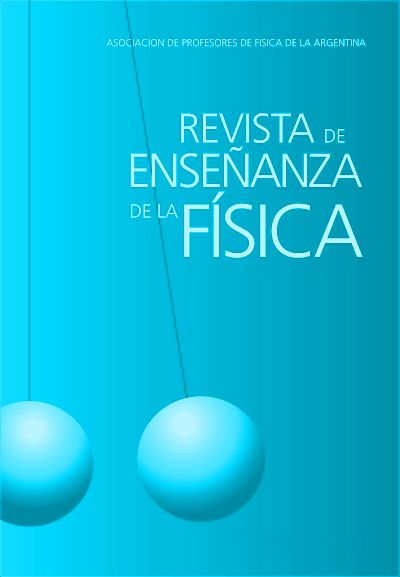A study about the understanding of the physical notions of Newtonian mechanics: the case of the center of mass
DOI:
https://doi.org/10.55767/2451.6007.v30.n2.22732Keywords:
Center of mass, Physical situation, Complexity, Idealization, ComprehensionAbstract
The understanding of the Center of Mass is described from a case study. The description is based on the analysis of the production of a group of university students when they solve some tasks proposed in a representative sample of contexts, a static mechanical context and a dynamic one, in which the Center of Mass is important for its resolution. In the study of conceptions, some theoretical tools of the Ontosemiotic Approach are used and adapted such as the configuration of mathematical objects of epistemic and cognitive type. The comparison between the epistemic configuration, organized by a teacher, and the cognitive configurations of the students, shows that the static context should include situations in which the process of idealization is favored, that the competent use of this notion in a specific task It provides the student with a partial knowledge and, on the other hand, that the transfer of knowledge from one context to another is not immediate, since students do not consider the complexity of the dynamic context.References
Apóstol, M. T. y Mnatsakanian, M. (2000). Finding Centroids, the Easy Way. Math Horizons, 8(1), 7-12.
Badillo, E., Font, V. y Edo, M. (2014).Representaciones matemáticas usadas en la resolución de un problema aritmético de reparto por niños del primer ciclo de primaria. UNO. Revista de Didáctica de las Matemáticas, 65, 59-69.
Boulter, C. J. (2000). Language, Models and Modelling in the Primary Science Classroom. En J.K. Gilbert y C.J. Boulter (Eds.), Developing Models in Science Education (289-305). London: Kluwer Academic.
Brown, D. y Cox, A. (2009). Innovative uses of video analysis. The Physics Teacher,47(3), 145-150.
Calderón, S. E. y Gil, S. (2011). Experimentos con objetos que caen con aceleración mayor que g. Latin American Journal of Physics Education, 5(2), 501-507.
Chacón, Á. E. R. y Rodríguez, O. L. D. R. (2009). La formalización de los conceptos físicos. El caso de la velocidad instantánea. Revista Educación y Pedagogía, 15(35), 55-67.
Collazos, M. C. A. (2009). Prototipo para la Enseñanza de la Dinámica Rotacional (Momento de Inercia y Teorema de Ejes Paralelos). Latin American Journal of Physics Education, 3(3), 619-624.
Duval, R. (2006). A cognitive analysis of problems of comprehension in a learning of mathematics. Educational Studies in Mathematics, 61(1-2), 103–131.
Feynman, R. P., Leighton, B. R. y Sands M. (2010). The Feynman Lectures on Physics, Volume I (The New Millennium Edition). Consultado en http://www.feynmanlectures.caltech.edu/I_19.html en octubre de 2018.
Font, M. V. (2016). Coordinación de Teorías en Educación Matemática: el caso del enfoque ontosemiótico. Perspectivas de Educação Matemática, 9(20), 256-277.
Godino, J. D. y Batanero, C. (1994). Significado institucional y personal de los objetos matemáticos. Recherches en Didactique des Mathématiques, 14(3), 325-355.
Johnson, R.B. y Onwuegbuzie, A.J. (2004). Mixed methods research: A research paradigm whose time has come. Educational Researcher, 33(7), 14-26.
López-García, V. (2004). La física de los juguetes. Revista Eureka sobre Enseñanza y Divulgación de las Ciencias, 1(1), 17-30.
Malaspina, U. V. (2007). Intuición, rigor y resolución de problemas de optimización. Revista Latinoamericana de Investigación en Matemática Educativa, 10(3), 365-399.
Malaspina, U. V. y Font, V. M. (2010). The role of intuition in the solving of optimization problems. Educational Studies in Mathematics, 75(1), 107-130.
Merriam, S. B. (1998). Qualitative Research and Case Study Applications in Education. Revised and Expanded from “Case Study Research in Education”. US San Francisco: Jossey-Bass Publishers.
Moreno, M.N., Font, M.V. y Maciel, R. J. (2016). La importancia de los diagramas en la resolución de problemas de cuerpos deformables en Mecánica: el caso de la fuerza de fricción. Ingeniare. Revista chilena de ingeniería, 24(1), 158-172.
Ruiz, G. G. (2003). El concepto estadístico de centro de gravedad. Números, Revista de Didáctica de las Matemáticas, 53, 43-53.
Santos, G., Otero, M. R. y Fanaro, M. D. L. A. (2000). ¿Cómo usar software de simulación en clases de Física? Caderno Brasileiro de Ensino de física, 17(1), 50-66.
Treeby, D. (2017). A Physical Proof of the Pythagorean Theorem. The Physics Teacher, 55(2), 92-93.
Young, H. D. y Freedman, R. A. (2013). Física universitaria. México: Pearson.
Downloads
Published
Issue
Section
License
Copyright (c) 2018 Nehemías Moreno Martínez, Vincenç Font Moll, Rita Guadalupe Angulo Villanueva

This work is licensed under a Creative Commons Attribution-NonCommercial-NoDerivatives 4.0 International License.
Aquellos autores/as que tengan publicaciones con esta revista, aceptan los términos siguientes:Los autores/as conservarán sus derechos de copiar y redistribuir el material, bajo los términos estipulados en la Licencia de reconocimiento, no comercial, sin obras derivadas de Creative Commons que permite a terceros compartir la obra bajo las siguientes condiciones:
- Reconocimiento — Debe reconocer adecuadamente la autoría, proporcionar un enlace a la licencia e indicar si se han realizado cambios. Puede hacerlo de cualquier manera razonable, pero no de una manera que sugiera que tiene el apoyo del licenciador o lo recibe por el uso que hace.
- NoComercial — No puede utilizar el material para una finalidad comercial.
- SinObraDerivada — Si remezcla, transforma o crea a partir del material, no puede difundir el material modificado.
- Los autores/as podrán adoptar otros acuerdos de licencia no exclusiva de distribución de la versión de la obra publicada (p. ej.: depositarla en un archivo telemático institucional o publicarla en un volumen monográfico) siempre que se indique la publicación inicial en esta revista.
- Se permite y recomienda a los autores/as difundir su obra a través de Internet (p. ej.: en archivos telemáticos institucionales o en su página web) antes y durante el proceso de envío, lo cual puede producir intercambios interesantes y aumentar las citas de la obra publicada. (Véase El efecto del acceso abierto).










